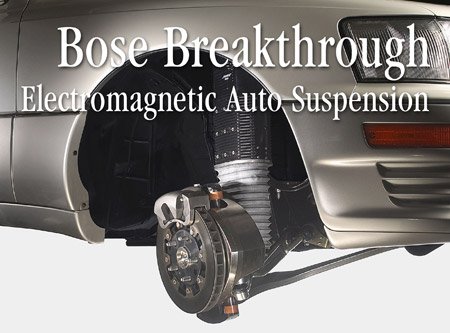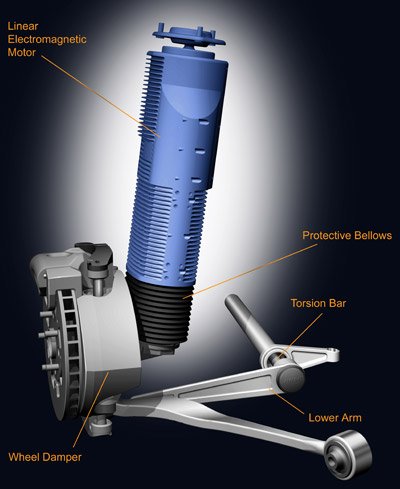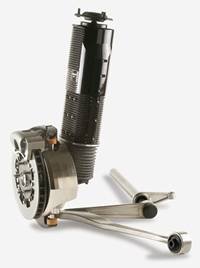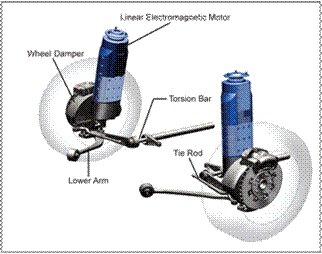Received this from a friend of mine. Thought someone here might find it interesting.
Mods, you could find some information which is not related.
Bose Breakthrough: Electromagnetic Auto Suspension
The name of Amar Bose has become synonymous with hi-fidelity sound. But Project Sound is something completely different. The 24-year-long secret project has developed a revolutionary auto suspension system that offers a magic carpet ride, thanks to some dense mathematical research and use of electromagnetics. Siliconeer presents a report on Bose’s latest breakthrough that has experts spellbound and reflects on its progenitor Amar Bose, the amazing septuagenarian wunderkind.

Entrepreneur and engineering whiz Amar Bose can at last look back with a pleasing sense of vindication at 24 years of research on a revolutionary auto suspension system which seemed like a pipedream when he began. Here’s what Automobile magazine has to say about his latest scientific breakthrough: “We have just returned from The Mountain (aka Bose Corporation headquarters in Framingham, Massachusetts) where we witnessed the first mega-breakthrough in car suspensions since the gas-pressurized shock. Is that hyperbolic enough for you?”
Supplanting almost 100 years of traditional spring-and-shock-absorber suspension systems, this new system from Bose uses electromagnetic motors in place of traditional shocks.

The motors, mounted on each wheel, receive input from sensors throughout the vehicle and react to bumps and potholes instantaneously, using downward force to extend the wheel into potholes while keeping the car level and the driver virtually unaware. As the wheel pops back up onto the road, the suspension recaptures nearly all the energy expended.
The system also improves handling, virtually eliminating body roll in tight turns and minimizing pitching motion during braking and acceleration. “This is the first time a suspension system is the same for a sports car and for a luxury car,” says Amar Bose.
The premise was simple, as Automobile magazine put it: “Develop a suspension system that would offer the magic carpet ride of a fine luxury automobile, yet provide the crisp handling of a high-performance sports car.” Easier said than done. Luxury automakers like Lotus, Infiniti and Mercedes-Benz have tried and failed.

The Bose suspension front corner module features simple strut and link construction. The linear electromagnetic motor is used as a telescoping suspension strut along with a two-piece lower control arm. A torsion bar connected to one end of the lower arm supports the weight of the vehicle. The wheel damper keeps the tire from bouncing and losing contact with the road. (All photographs and illustrations, including cover and opposite page, courtesy Bose Corporation)
For Bose, the search began with a question he asked himself several decades ago. “I wondered,” he told Popular Science magazine, “what a car suspension could do without hardware constraints, if you could have any force you wanted, at any time, between the body and the wheel.”
In 1980 he decided to work on it. As is his wont, he ignored the 100-year-old beaten track of automakers who had perfected fluid-based suspension hardware. He threw away the hardware model, and along with it the limitations.
A shock absorber can only absorb energy. Fluid inertia makes hydraulic systems too sluggish.
Bose focused on figuring out mathematically what kind of performance was theoretically possible. Five years of mathematical analysis revealed a tremendous performance gap. There was no way any adjustments to existing shock-absorber technology could close it. So Bose engineers focused on an electromagnetic solution. All they needed was four things: (a) high-efficiency, high-power linear motors and (b) amplifiers, (c) extremely complex control algorithms to stabilize the motors and (d) superfast microcomputers to run the system. So what if none of this stuff existed? Bose decided to tackle the first three and hope the industry came up with the fourth.
Bose’s suspension team took on the challenge of designing high-speed linear motors, control algorithms and high-efficiency amplifiers. They expected the computer industry to get to the point after a while on their fourth essential item, high-speed processing. They began testing designs and software. By 1989, the team developed a prototype ready to be tested on the road.
In place of traditional shock absorbers, the prototype had linear electromagnetic motors installed at each wheel. Based on technology Bose pioneered at MIT, power amplifiers deliver electricity to the motors in response to signals from the control algorithms. The nimble motors are so quick and forceful, they can extend downward to roll the tire through a deep rut and then retract so fast that the all a motorist senses is a mild stirring. On the far side of the pothole, the motor operates as a generator, so the suspension requires less than a third the power of a typical car air- conditioning system.
So what is this wonderful suspension system actually like? Proud Bose engineers have been taking people on test runs, and those who have experienced it are dazzled.

(Top) Front and (middle) rear view of two vehicles of the same make and model performing an International Standards Organization double lane change maneuver.
(Bottom) Two vehicles of the same make and model performing an aggressive cornering maneuver.
(In all photographs above, the vehicle on the left has the original factory-installed suspension and the vehicle on the right has the Bose suspension system. Both vehicles are being driven at the same speed.)
An Automobile magazine critic describes his experience: “To witness the miracle, we were strapped into a retrofitted Lexus LS400 perched atop a Bose-designed ride simulator (itself an engineering tour de force that will most likely replace the towering three-story edifices currently used by car companies around the world). The initial experience programmed into the simulator emulated a terribly choppy road with a whole lot of high frequency energy ‘exciting’ the wheels. Butts wiggled and stomachs hopped up and down. It was a buckboard. A martini shaker. The research engineers working the controls were just a little too jolly watching the journalists shaken, not stirred.
“Next, in Bose mode, we attacked the same horrid road, but inside the passenger compartment, we were sailing along on a cruise ship. The teensiest of cradle rock. “Looking at a mirror on an adjacent wall of the garage, we could see our LS400’s tires chattering and bashing along, as if they belonged to another car, not the one in which we were blissfully rocking along. It was mind-boggling, unbelievably astonishing, no less than earth shattering.”
There you have it. An amazing technological breakthrough that is remarkable not just for its intrinsic value, but also because of the way it was done: 24 years of faith in innovation and research. In today’s age of tight-fisted bean counting executives with one eye constantly on stock prices, how the on earth is it possible?
For the answer you have to look at one man—a trailblazing septuagenarian who at a very frisky 75 still manages to have the insatiable curiosity of a toddler.
Throughout his life, Amar Gopal Bose has had the avid curiosity of a child, the tenacity to follow it through, and the gumption to flout conventional thinking.
Amar Bose (c) and Y.W. Lee, one of his mentors (far left), with famed MIT mathematician Norbert Wiener at the university’s Research Laboratory of Electronics in 1955.
He was a legendary MIT professor with a cult following, and Bose Corporation, a company he built from scratch, has made breakthroughs across a mind-boggling range of fields—acoustics, aviation, defense, nuclear physics, you name it.
By the time he was 13, he could fix radios, and when his father’s business went belly-up during World War II, young Amar helped support the family by fixing radios after school.
At his alma mater MIT, when he was hired to teach network theory, he threw away the syllabus and confronted his students with nine blackboards. He urged students to ask tough questions, expected section leaders to think out loud to illustrate the problem-solving process, abolished exam time limits and allowed open books.
His classes developed a cult following. One was described as Life 101. Many classes drew mathematicians, physicists, biologists.
William H. Brody, now the president of Johns Hopkins University, says of him: “He would walk into a lecture to 350 students, and you could hear a pin drop. He commanded a lot of respect, because of the force of his intellect and his total dedication to the students. His class gave me the courage to tackle high-risk problems; it equipped me with the problem-solving skills I needed to be successful in several careers. Amar Bose taught me how to think.”
At the end of the day it’s Bose’s way of thinking that remains such a unique gift: Simply put, it is just a wondrously dogged courage to chase an idea to its very limit. Bose Corporation may have a billion-dollar turnover, but Bose says he started the company to chase ideas, not make money. And he kept his company private so he could do that.
“I would have been fired a hundred times at a company run by MBAs,” he told Popular Science magazine. “But I never went into business to make money. I went into business so that I could do interesting things that hadn’t been done before.”
So number crunchers’ myopic obsession with the bottom line was out, a commitment to pure research was in. There have been instances where Bose has allowed a project to continue even when he thought it may not succeed.
In 1983 engineering graduate student Ken Jacob enrolled in Bose’s acoustics class during his final semester at MIT. Jacob planned to design sound for Broadway productions. “Within 20 minutes of the start of that first lecture,” Jacob said, “all my plans had changed. Professor Bose connected everything I had learned and put all the pieces together. I said, I’ve got to work for this guy.’”
Jacob was true to his word. He became director and chief engineer of Bose’s Live Music Technology Group. In 1994 he unveiled the Bose Auditioner program, a software tool that allows acoustic engineers to hear precisely what a proposed audio system will sound like from any seat in a large venue even before building construction begins.

The Bose suspension front corner module
On the day that Jacob unveiled the project, Bose admitted that he hadn’t expected it to succeed. “He let me work on that with a team of five engineers for 10 years—most of the time thinking that it was impossible,” Jacob says, shaking his head in disbelief.
Bose says it’s the principle of allowing bright minds to search for answers that was more important to him. “I thought the computational power wouldn’t be there,” he says. “But the problem was tough enough and the team was talented enough that I thought their research would yield something good.” The funny thing was that Bose was proved wrong: The program works today.

Diagrammatic view of Bose suspension front components
The program has been used to design public address systems at the Staples Center in Los Angeles, the Sistine Chapel, and even Masjid al-Haram, the grand mosque at Mecca, a challenging environment, full of reverberating marble, with a history of failed audio solutions.
Popular Science, in a long, admiring essay, sums it up best about the merit of Amar Bose’s mindset and contribution.
“The value of Amar Bose—and by extension, his company—isn’t so much in the things he has invented, but in the sense of possibility he inspires,” the magazine wrote. “Bose reminds us that we could all afford to be much more skyward-looking, far-fetched and curious, and that we could all believe more strongly in our own potential to create.”
 (1)
Thanks
(1)
Thanks











 Same thing I've got to say too. If that's the case then it'll all be hype hype and hype. Nothing materialistic.
Same thing I've got to say too. If that's the case then it'll all be hype hype and hype. Nothing materialistic.